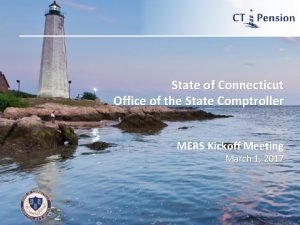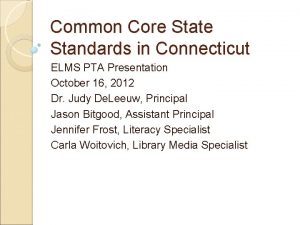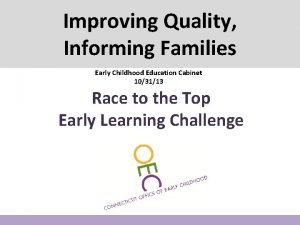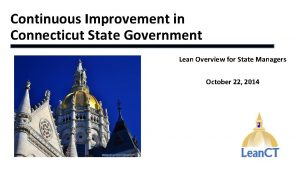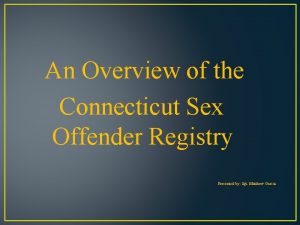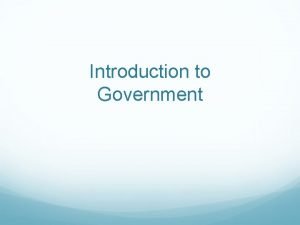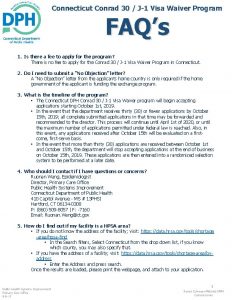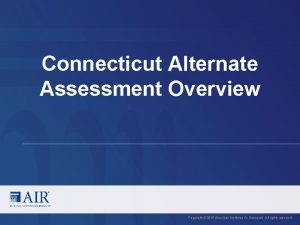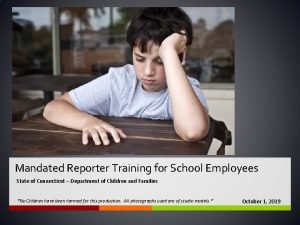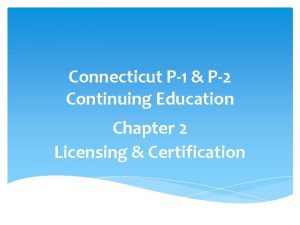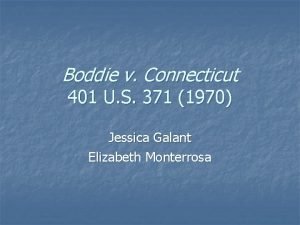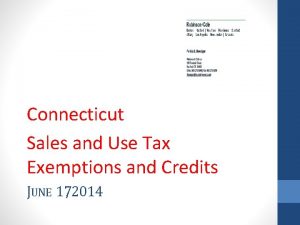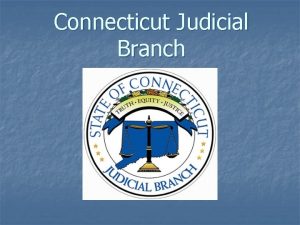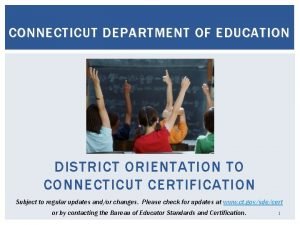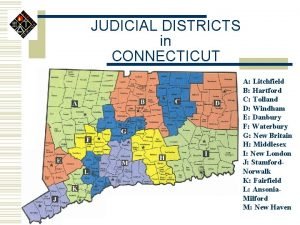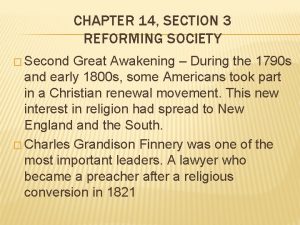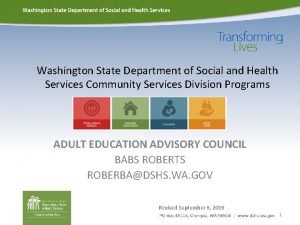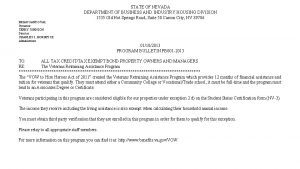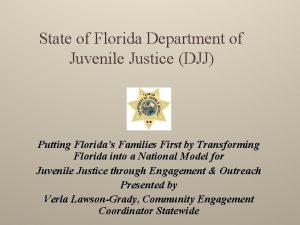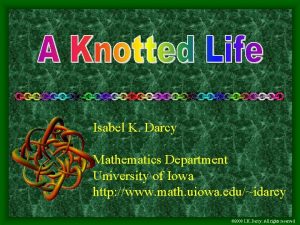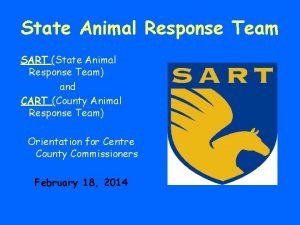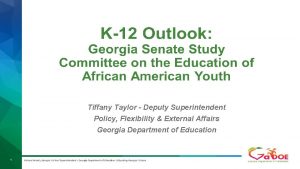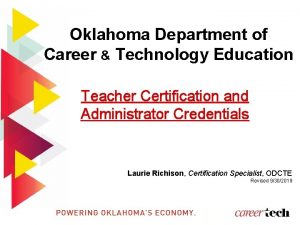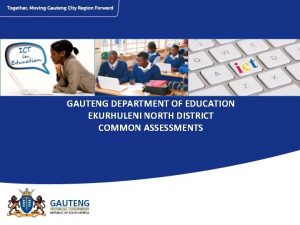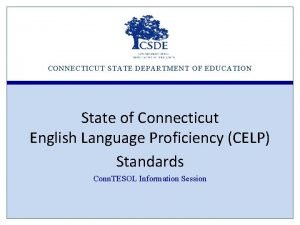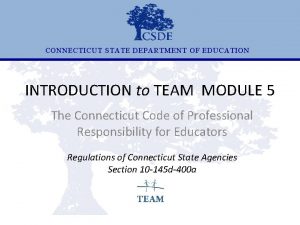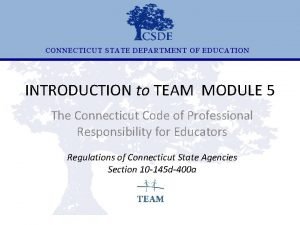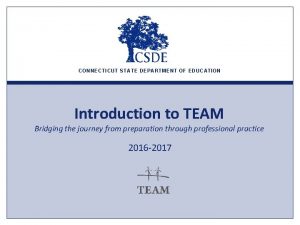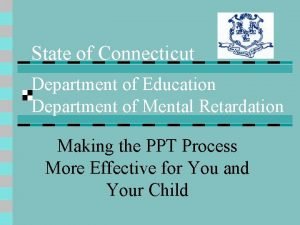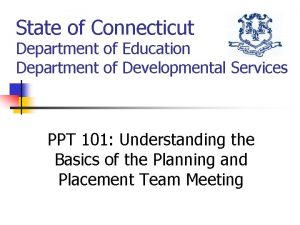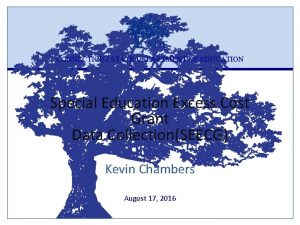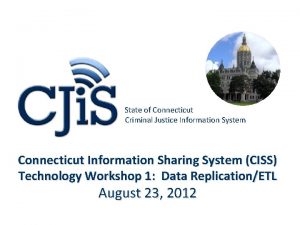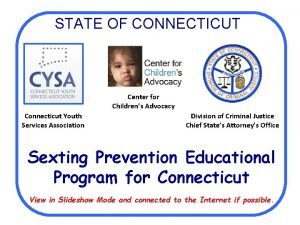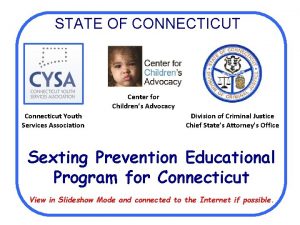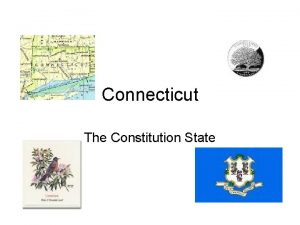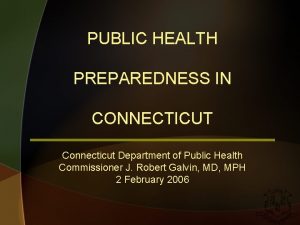CONNECTICUT STATE DEPARTMENT OF EDUCATION Introduction to TEAM




















































- Slides: 52

CONNECTICUT STATE DEPARTMENT OF EDUCATION Introduction to TEAM Bridging the journey from preparation through professional practice 2017 -2018

Learning Targets 1. Participants will know: q The mission and goals of the TEAM Program; q The expectations of the TEAM Program and their district; and q What supports are available from the district. 2. Participants will be able to: q Locate TEAM web-based tools and online resources; q Discuss the Module Process with their mentor; q Create a user account on www. ctteam. org; and q Develop a two-year plan mentoring plan. 2 | Connecticut State Department of Education

What is the TEAM Program? Legislation passed in October 2009 has established a Teacher Education and Mentoring (TEAM) Program for the purpose of providing support and professional growth for beginning teachers. 3 | Connecticut State Department of Education

What is the Mission of the TEAM Program? The mission of the TEAM Program is: to promote excellence, equity and high achievement for Connecticut students by engaging teachers in purposeful exploration of professional practice through guided support and personal reflection. 4 | Connecticut State Department of Education

Why is TEAM so Important? q On-Going Support q Formative Process q Professional Growth and Development 5 | Connecticut State Department of Education

Who are the TEAM Program Players? q Beginning teachers who hold an initial or interim initial certificate. q District Facilitator q TEAM Coordinating Committees q Administrators q. Trained Mentors q Trained Reflection Paper Reviewers q CT Department of Education (CSDE) q Regional Education Service Centers (RESCs) 6 | Connecticut State Department of Education

How will my District Support the TEAM Program? q District Facilitator § An individual appointed to serve as a liaison between CSDE, district, beginning teachers, and mentors regarding requirements of the TEAM program. q TEAM Coordinating Committee § A district committee that plans, implements and monitors the district’s TEAM Program. q District Support Plan § A plan outlining how your district will support beginning teachers and mentors. 7 | Connecticut State Department of Education

How will my District Support the TEAM Program? q TEAM Mentors § An accomplished teacher who has been selected by the school district and has completed the TEAM Program Initial Support Training. § This person is responsible for providing guidance to the beginning teacher as he or she progresses through the year and the TEAM Program requirements. q Reflection Paper Reviewers § Educators selected by districts and trained to read and review reflection papers 8 | Connecticut State Department of Education

How will my District Support the TEAM Program? q Administrator § Is an instructional leader who can provide guidance and support to help teachers grow professionally. § The individual who will review and sign-off on the Profession Growth Action Plan (PGAP), which is an agreement that he or she can support the activities or resources requested. § Can help the teacher make connections between TEAM, teacher evaluation, and professional learning. 9 | Connecticut State Department of Education

What is the Design of the TEAM Program? q TEAM is a professional growth model aligned with five domains of Connecticut’s Common Core of Teaching (CCT) § Classroom Environment, Student Engagement and Commitment to Learning § Planning for Active Learning § Instruction for Active Learning § Assessment for Learning § Professional Responsibilities and Teacher Leadership 10 | Connecticut State Department of Education

The Common Core of Teaching Emphasizes: q High Student Achievement and success for all students q Differentiation of instruction to support students q Collaboration with colleagues and families to meet the diverse needs of all students q. Commitment to the analysis of teaching and continuous professional growth and learning 11 | Connecticut State Department of Education

Aligning TEAM to CT Common Core of Teaching Domain 1 Content and Essential Skills TEAM Program Modules EMBEDDED Domain 2 Classroom Environment, Student Engagement and Commitment to Learning Domain 3 Planning for Active Learning MODULE 1 Domain 4 Instruction for Active Learning MODULE 3 Domain 5 Assessment for Learning MODULE 4 Domain 6 Professional Responsibilities and Teacher Leadership MODULE 5 MODULE 2 12 | Connecticut State Department of Education

The TEAM Module Process 13 | Connecticut State Department of Education

Module Five is Different q Modules 1 -4 require a reflection paper to be submitted for review at the end of the 8 -10 week guided professional learning experience. q Module 5 is a facilitated conversation using scenarios that prompt honest discussions about possible ethical dilemmas regarding: § § Relationships with students Professional ethics Community and family Bullying q Upon completion of the facilitated conversation, teachers complete an online questionnaire accessed through the TEAM online dashboard. 14 | Connecticut State Department of Education

The TEAM Module Process • Analyze teaching and learning and identify a module focus using the CCT Performance Profile • Create an Initial Summary using specific examples to describe what the teacher and students are doing in the focus area at the start of the module. • Write a Professional Growth Goal and Action Plan (PGAP) describing what the teacher wants to learn, how s/he will learn it, and how it should improve teaching practice and student performance. • Using the learning activities/resources identified in the PGAP, develop new learning that will be used to improve teaching practice. • Implement new learning. • Document specific examples of what the teacher did to develop new learning. • Monitor impact of plan to determine readiness to draft reflection paper. • Record specific examples of what the teacher learned. • Record analyze specific examples of how changes in teaching practice result in better outcomes for students. • Reflect on and describe: what you learned and how you learned it; how you used new learning to improve teaching; the positive impact the improvements in teaching practice had on students. • Document the positive impact of the module by comparing the changes in teaching practice and outcomes for student to what was escribed in the Initial Summary. 15 | Connecticut State Department of Education

Step 1 TEAM Module Process q Plan for Professional Growth § Explore CCT Performance Profile § Select one indicator for professional growth and development § Record specific examples/evidence of practice § Create an Initial Summary describing current practice § Develop a Goal § Record meetings in Log (mentor records, mentee verifies) § Document work in Journal 16 | Connecticut State Department of Education

CCT Performance Profiles available on ctteam. org • Read the Performance Profile going across from left to right. • Note language changes as you move across the continuum Domain 1: Teachers promote student engagement, independence and interdependence in learning by facilitating a positive learning community by: CCT Continuum of Effective Teaching Practice Indicators 1. Creating a class climate that is responsive to and respectful of the needs of students with diverse backgrounds, interests and performance levels o Little indication that the students’ backgrounds, interests and skill levels are considered in selecting content and creating learning opportunities. o Considers students’ backgrounds, interests and skill levels in making connections to the content and creating learning opportunities. o Treats students as individuals respecting their diverse needs and recognizes that the background of each student may differ dramatically within the classroom and school. o Designs learning opportunities which build upon students’ diverse backgrounds, interests and skill levels. o Creates a classroom environment in which individual students are treated with respect regardless of differences in backgrounds, interests and skill levels. o Designs learning opportunities which capitalize on students’ diverse backgrounds and interests to enrich the learning community. o Creates a classroom environment which supports students in becoming role models for treating others with respect and dignity. 17 | Connecticut State Department of Education

CCT Performance Profiles available on ctteam. org • Read the Performance Profile going across from left to right. • Note language changes as you move across the continuum Domain 1: Teachers promote student engagement, independence, and interdependence in learning by facilitating a positive learning community by: CCT Indicators 1. Creating a class climate that is responsive to and respectful of the needs of students with diverse backgrounds, interests and performance levels The indicator begins with the Domain stem statement Continuum of Effective Teaching Practice o Little indication that the students’ backgrounds, interests and skill levels are considered in selecting content and creating learning opportunities. o Considers students’ backgrounds, interests and skill levels in making connections to the content and creating learning opportunities. o Treats students as individuals respecting their diverse needs and recognizes that the background of each student may differ dramatically within the classroom and school. o Designs learning opportunities which build upon students’ diverse backgrounds, interests and skill levels. o Creates a classroom environment in which individual students are treated with respect regardless of differences in backgrounds, interests and skill levels. o Designs learning opportunities which capitalize on students’ diverse backgrounds and interests to enrich the learning community. o Creates a classroom environment which supports students in becoming role models for treating others with respect and dignity. 18 | Connecticut State Department of Education

CCT Performance Profiles available on ctteam. org • Read the Performance Profile going across from left to and the right. • includes Note indicatorlanguage changes as you move across the continuum Domain 1: Teachers promote student engagement, independence and interdependence in learning by facilitating a positive learning community by: CCT Continuum of Effective Teaching Practice Indicators 1. Creating a class climate that is responsive to and respectful of the needs of students with diverse backgrounds, interests and performance levels o Little indication that the students’ backgrounds, interests and skill levels are considered in selecting content and creating learning opportunities. o Considers students’ backgrounds, interests and skill levels in making connections to the content and creating learning opportunities. o Treats students as individuals respecting their diverse needs and recognizes that the background of each student may differ dramatically within the classroom and school. o Designs learning opportunities which build upon students’ diverse backgrounds, interests and skill levels. o Creates a classroom environment in which individual students are treated with respect regardless of differences in backgrounds, interests and skill levels. o Designs learning opportunities which capitalize on students’ diverse backgrounds and interests to enrich the learning community. o Creates a classroom environment which supports students in becoming role models for treating others with respect and dignity. 19 | Connecticut State Department of Education

CCT Performance Profiles available on ctteam. org • Read the Performance Profile going across from left to right. • Note language changes as you move across the continuum Domain 1: Teachers promote student engagement, independence and interdependence in learning by facilitating a positive learning community by: And CCT the performance descriptors Indicators across the continuum 1. Creating a class climate that is responsive to and respectful of the needs of students with diverse backgrounds, interests and performance levels o Little indication that the students’ backgrounds, interests and skill levels are considered in selecting content and creating learning opportunities. Continuum of Effective Teaching Practice o Considers students’ backgrounds, interests and skill levels in making connections to the content and creating learning opportunities. o Treats students as individuals respecting their diverse needs and recognizes that the background of each student may differ dramatically within the classroom and school. o Designs learning opportunities which build upon students’ diverse backgrounds, interests and skill levels. o Creates a classroom environment in which individual students are treated with respect regardless of differences in backgrounds, interests and skill levels. o Designs learning opportunities which capitalize on students’ diverse backgrounds and interests to enrich the learning community. o Creates a classroom environment which supports students in becoming role models for treating others with respect and dignity. 20 | Connecticut State Department of Education

Initial Summary The Initial Summary should include specific examples/evidence of: q What the teacher is doing at the start of the module. q What the students are doing at the start of the module. 21 | Connecticut State Department of Education

TEAM Module Goal The Professional Growth Goal should : q Connect to the selected CCT Performance Profile Indicator. q Describe what the teacher wants to learn. q Explain what impact the teacher anticipates the application of new learning will have on the students: – I want to learn how to improve transitions from whole class. to group work be more actively engaged in group work. – As a result, students will _______________. q Be achievable in 8 – 10 weeks. 22 | Connecticut State Department of Education

Step 2 TEAM Module Process Develop a Professional Growth Action Plan (PGAP) q Identify specific activities to develop new learning. q Select resources to support professional growth activities. q Record the teacher learning activities and resources online. q Create and record a schedule for future meetings. q Communicate with the building administrator to share Professional Growth Action Plan. 23 | Connecticut State Department of Education

Professional Growth Action Plan (PGAP) created online by entering of the following components: Goal, Activities/Resources, Anticipated Timeline, and Proposed Meeting Dates Goal (Related to CCT, addresses a relevant and achievable teacher learning need and includes outcomes for students) Teacher Learning Activities/Resources To be discussed with administrator Activities Resources Needed Anticipated Timeline for Module Completion (Recommend 8 -10 week period) Proposed Meeting Dates 24 | Connecticut State Department of Education

Step 3 TEAM Module Process Develop, Implement, and Apply New Learning q Engage in activities to develop new learning. q Try out new learning in the classroom. q Document changes in practice and impact on students. q Compare examples/evidence to the Initial Summary. q Record reflections, evidence and decisions. 25 | Connecticut State Department of Education

Step 4 TEAM Module Process Write Reflection Paper Create a reflection paper (no more than 3000 words) that includes: § a description of what the teacher did to develop new learning; § an explanation of what the teacher learned from the learning activities and resources; § specific examples/evidence of how the teacher used new learning to improve teaching practice; § specific examples/evidence of how student performance/ learning improved as a result of changes in teaching practice; and § specific examples of positive outcomes for students. 26 | Connecticut State Department of Education

Module Submission q Teachers should submit each module when the mentor has signed-off. q The module process is expected to take between 810 weeks to complete. Please Note: No more than one reflection paper should be submitted within a four week period. 27 | Connecticut State Department of Education

The TEAM Module Process 28 | Connecticut State Department of Education

A Web-Based Program Beginning teachers and mentors will have an online dashboard and workspace to access tools to assist in completing TEAM requirements: q CCT Performance Profiles (self-analysis) q Professional Growth Action Plan (PGAP) q Beginning Teacher and Mentor Meeting Log q Journal for Beginning Teacher q Journal for Mentor q Reflection Paper 29 | Connecticut State Department of Education

Beginning Teacher Dashboard 30 | Connecticut State Department of Education

Beginning Teacher Module Center 31 | Connecticut State Department of Education

BT/Mentor Meeting Log Note: Mentors are responsible for documenting meetings with their beginning teacher in the meeting log. Beginning teachers verify the accuracy of the meetings. 32 | Connecticut State Department of Education

My Personal Journal 33 | Connecticut State Department of Education

Reflection Paper Tracker 34 | Connecticut State Department of Education

What Happens after I Complete my Reflection Paper? q Share the reflection paper with mentor feedback and sign-off Note: Mentor sign-off indicates that reflection paper is consistent with on-going work during module. q Submit reflection paper electronically via www. ctteam. org for review. q Teachers will be notified via ctteam whether their reflection paper has met the completion standard. 35 30 | Connecticut State Department of Education

Who will review my Reflection Papers? Options for the Review of Reflection Papers Districts have two options: q In-District Review § Trained reviewers from the district will review Reflection Papers. q Regional Review Committee § Trained reviewers representing all Connecticut districts will review the reflection paper. 36 | Connecticut State Department of Education

Three Criteria for Success • Development of New Learning • Impact on Practice • Impact on Students 37 | Connecticut State Department of Education

Criteria I Development of New Learning q Describes how the teacher developed new learning; and q Explains what the teacher learned from the selected activities and resources and/or thinking more deeply about her/his practice. 38 | Connecticut State Department of Education

Criteria II Impact on Practice Explains, using specific examples/evidence how the teacher’s practice is different. 39 | Connecticut State Department of Education

Criteria III Impact on Students Explains, using specific examples/evidence, how student performance/learning has improved as a result of changes in the teacher’s practice. 40 | Connecticut State Department of Education

Reflection Paper Results What happens if my Reflection Paper does not meet the criteria for successful completion? Consider doing the following q Read sample PD Papers found on www. ctteam. org under “Module Resources. ” q Go back to the journal for additional data. q Engage in additional professional growth activities. q Collect additional data. q Continue to engage in discussions with mentor. q Submit revised Reflection Paper. 41 | Connecticut State Department of Education

TEAM Completion What happens when a I successfully complete all the required modules? q Your superintendent will verify that the you have completed the TEAM Program Requirements. q You are now eligible to apply for provisional certification. 42 | Connecticut State Department of Education

TEAM Completion What happens if I do not successfully complete all the required modules by the completion date? q Failure to successfully complete TEAM will result in the inability to advance your initial certificate to a provisional certificate. q You will not be able to renew your initial certificate and upon expiration, will no longer be able to teach in a CT public school. *Please see the TEAM Program Manual for additional details. 43 | Connecticut State Department of Education

Additional Tools/Resources q Sample Module Documents q Sample Reflection Papers q Reflection Paper Criteria and Feedback q Recommended Resources q Sample District Support Plans q Online Orientations q Monthly Electronic Communications 44 | Connecticut State Department of Education

TEAM TWO-YEAR BEGINNING TEACHER SUPPORT PLAN q Anticipated timeline of participation q Module(s) that will be completed during the 2016 -17 school year q Module(s) that will be completed during the 2017 -18 school year q Anticipated circumstances, such as a planned leave of absence (i. e. , maternity leave, planned medical leave, etc. ). that may require a third year 45 | Connecticut State Department of Education

Connecting the Dots TEAM Early Career Teachers Mentor Support 8 -10 Week Modules (incremental learning) Success Determined by: q Teacher Learning q Impact on Practice q Outcomes for Students Educator Evaluation and Support Team and Evaluation Teacher Outcomes q Collaboration q High-quality Feedback q Standards-Based Professional Learning q Data-based Decisions Student Outcomes q Data-based Decisions q Improved student learning All Educators Year-long Process Evaluated through Analysis of: q Performance and Practice q Student Growth and Development q Whole-school Learning q Parent or Peer Feedback Local and regional boards of education shall coordinate the teacher education and mentoring program and the teacher evaluation and support program, provided they are kept separate. | Connecticut State Department of Education 46

Connecting TEAM, Evaluation and Support and CCS One teacher’s thinking… Grade 8: History Teacher Reflections: As I worked with my mentor I realized that if I wanted my students to think more deeply about content and be more independent learners, I needed to think differently about my practice. As a result, I drafted possible goals for my TEAM Modules that supported my student learning goal that I developed as part of my teacher evaluation and support plan. 47 | Connecticut State Department of Education

Connecting TEAM, Evaluation and Support and CCS . Evaluation- Student Learning Goal (Broad): Students will improve their competence in reading comprehension of informational texts using the concepts, themes and information presented in history. Possible TEAM Module Goals Module One: Classroom Environment I will learn and apply a variety of strategies to create a learning environment where students feel invited to share their views without fear of judgment. CCS Application: Students will logically and objectively prove their views with authentic evidence and supporting facts. Module Two: Planning I will learn about and incorporate a variety of strategies into my planning to teach academic vocabulary in history. I anticipate that my students will be able to proficiently use historical terms in their writing. CCS Application: Students will use academic vocabulary to build students’ ability to access more complex texts for reading and writing. Module Three: Instruction Module Four: Assessment I will learn about and apply research-based instructional strategies in my history lessons so that my students will be able to demonstrate a deeper understanding of the unit on slavery. I will learn about, create and communicate assessment criteria so that students can self-assess a practice performance task that combines literacy and history. CCS Application: Students will read carefully and grasp information, arguments, ideas and details based on text evidence. CCS Application: Students will base their writing on evidence from texts using established criteria. 48 | Connecticut State Department of Education

I believe that reaching out to my coworkers for assistance, researching strategies in publications, and keeping a willingness to learn from others will contribute to my professional growth and a long, successful career in teaching. Reviewing the CCT Performance Profile was extremely helpful in examining and identifying my teaching practices prior to this process When I started this module, my classroom was almost 100 percent teacher driven. By the end of the module, there was a noticeable sharing of classroom responsibilities and a greater participation by the students in the learning process. 40

Contact Information For questions, please contact: the TEAM Program Office at 860 -713 -6820 or email For questions regarding technical issues, please contact Michael Mahoney at 860455 -1537 For questions regarding training, please contact your local RESC. Claudine Primack Program Manager Gady Weiner Data Manager CSDE Contacts 860 -713 -6841 claudine. primack@ct. gov 860 -713 -6836 gady. weiner@ct. gov 50 41 | Connecticut State Department of Education

The most valuable resource that all teachers have is each other. Without collaboration, our growth is limited to our own perspectives. ” Robert John Meehan rockmyclass. com

CONNECTICUT STATE DEPARTMENT OF EDUCATION Thank you!
 State of connecticut office of the state comptroller
State of connecticut office of the state comptroller Common core state standards ct
Common core state standards ct Southern connecticut state university public health
Southern connecticut state university public health State of connecticut division of criminal justice
State of connecticut division of criminal justice Connecticut early childhood education cabinet
Connecticut early childhood education cabinet Oklahoma state standards
Oklahoma state standards Connecticut compromise
Connecticut compromise Lean manufacturing connecticut
Lean manufacturing connecticut Connecticut college transfer
Connecticut college transfer Sex offender registration in connecticut
Sex offender registration in connecticut Vanderman manufacturing company
Vanderman manufacturing company Vinelink ct
Vinelink ct New haven connecticut
New haven connecticut Connecticut conrad 30
Connecticut conrad 30 Acessament
Acessament Mandated reporter training connecticut
Mandated reporter training connecticut P2 plumbing license
P2 plumbing license Alivia boddie
Alivia boddie New hampshire coastline length
New hampshire coastline length Connecticut manufacturing sales tax exemption
Connecticut manufacturing sales tax exemption Connecticut judicial branch
Connecticut judicial branch Ct sde certification
Ct sde certification Connecticut surplus lines tax
Connecticut surplus lines tax Connecticut
Connecticut Connecticut judicial districts
Connecticut judicial districts Csde tcs
Csde tcs John haynes connecticut
John haynes connecticut Started an all-female academy in hartford, connecticut.
Started an all-female academy in hartford, connecticut. Bureaucratic bypass syndrome
Bureaucratic bypass syndrome Team spirit becomes team infatuation
Team spirit becomes team infatuation The white team cheers for the blue team, just like
The white team cheers for the blue team, just like Washington state department of social and health services
Washington state department of social and health services State of nevada department of business and industry
State of nevada department of business and industry State of nevada department of business and industry
State of nevada department of business and industry State of florida department of juvenile justice
State of florida department of juvenile justice State of alabama department of finance
State of alabama department of finance Texas state majors
Texas state majors Nysdot hdm chapter 5
Nysdot hdm chapter 5 Isabel darcy
Isabel darcy The state department us for
The state department us for Penn state meteorologists
Penn state meteorologists Jackson state university finance department
Jackson state university finance department State of nevada department of business and industry
State of nevada department of business and industry Michigan state astronomy
Michigan state astronomy Pennsylvania state animal response team
Pennsylvania state animal response team Tiffany taylor georgia department of education
Tiffany taylor georgia department of education Amy williamson iowa department of education
Amy williamson iowa department of education Oklahoma alternative placement program
Oklahoma alternative placement program Sindh education and literacy department
Sindh education and literacy department Government of karnataka department of technical education
Government of karnataka department of technical education Gauteng north district schools
Gauteng north district schools 10 pillars of education in gauteng
10 pillars of education in gauteng Gde strategic goals
Gde strategic goals
